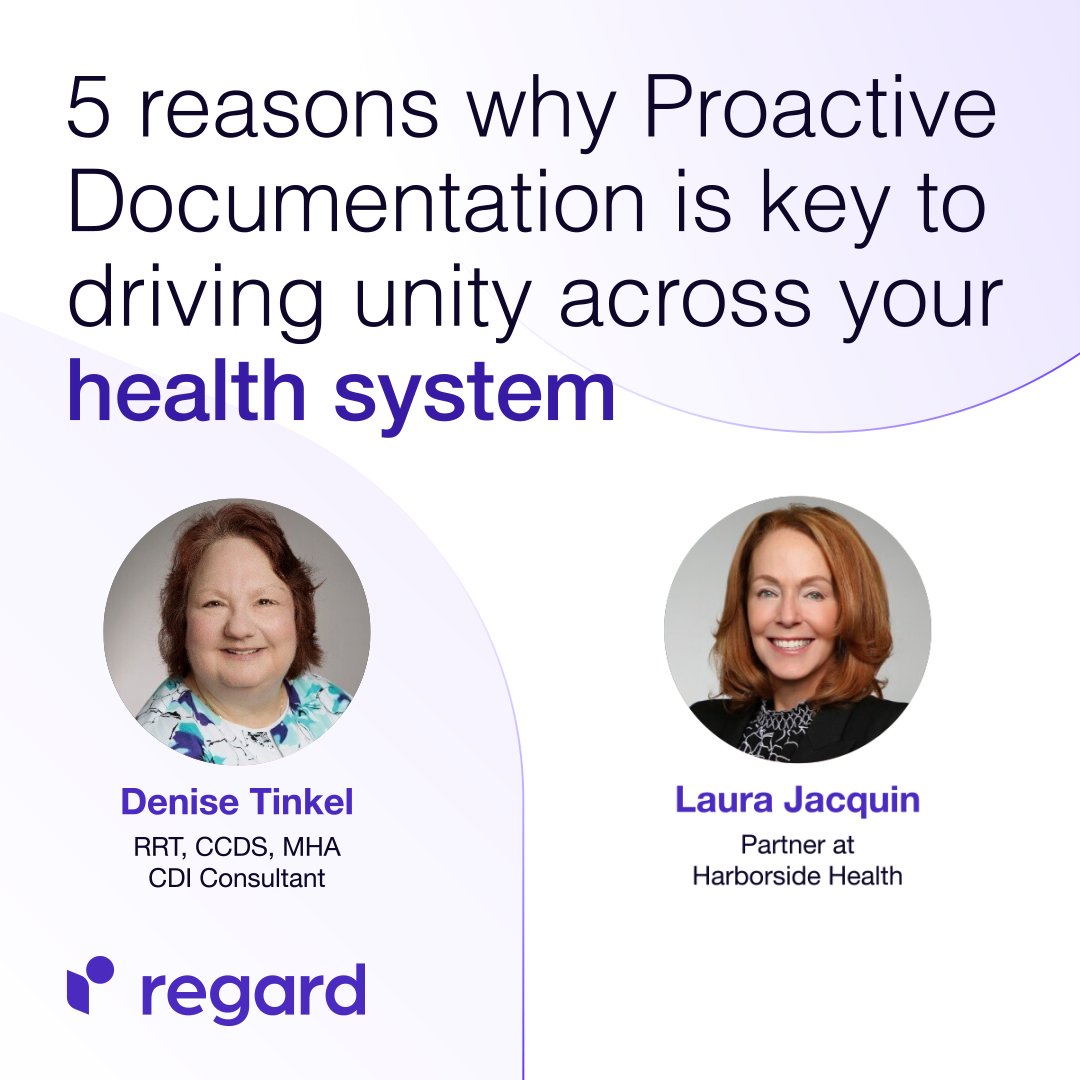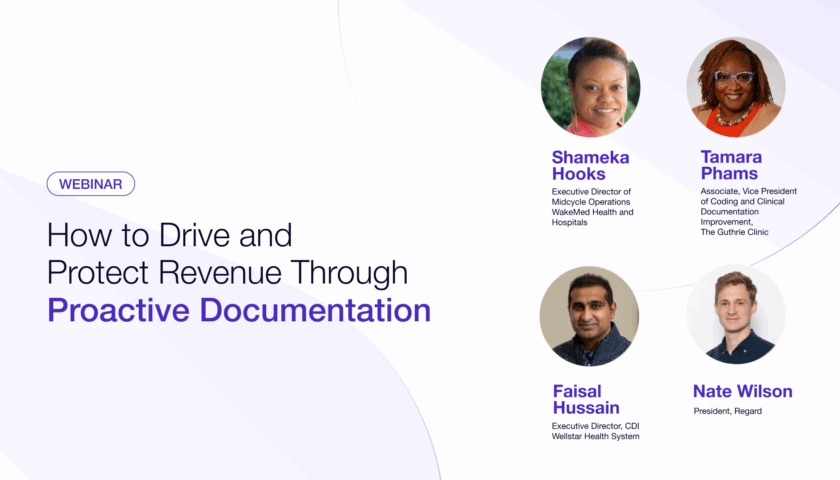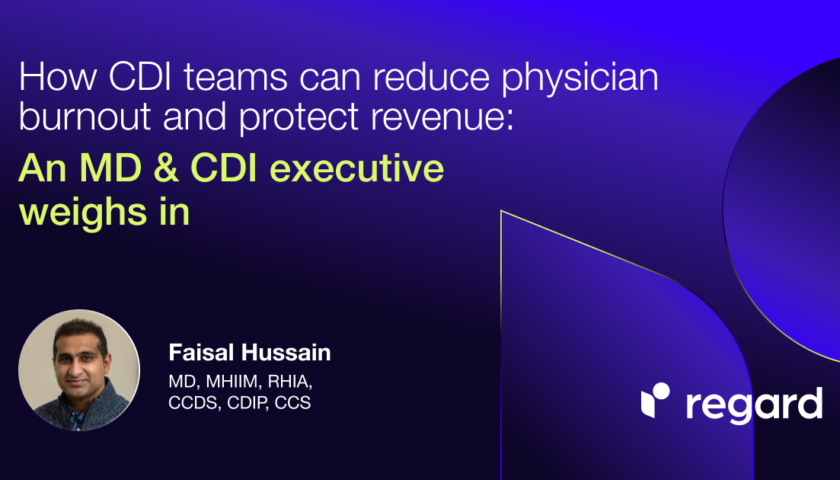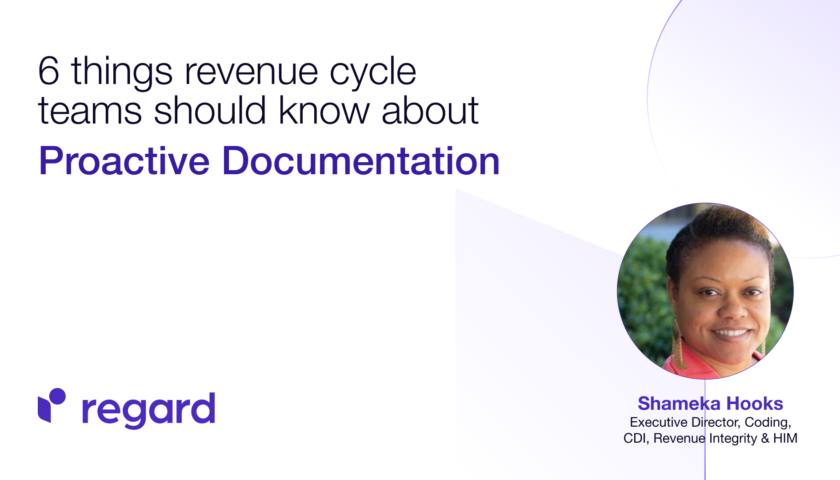
Thanks to modern medical and technological advancement, healthcare moves fast. While this translates into more lives saved, it also means our health system never stops growing in complexity––and the need for precise yet comprehensive communication between clinical and administrative teams.
Silos in healthcare, whether across medical specialties or business functions, is one of the industry’s most pressing challenges. According to the World Economic Forum, there are a variety of contributing factors, including “structural, economic, practical, technological and even human. Whatever the cause (or causes), silos in healthcare reduce cost efficiency, impact the quality of care, and lead to the duplication of services (that is, they create waste).”
More than ever, healthcare needs tools and processes that drive unity.
Enter: Proactive Documentation. This methodology and associated tools foster unity and collaboration across health systems while boosting patient care––and the bottom line.
We gathered insight on this topic from both clinical and operational angles in an interview with CDI consultant Denise Tinkel, RRT, CCDS, MHA, and healthcare executive Laura Jacquin, a partner at Harborside Health. They shared five key reasons Proactive Documentation can improve workflows, reduce friction, and ultimately create a more unified and efficient healthcare environment.
#1 Proactive Documentation heals the tension between administrative and clinical teams, while today’s reactive approach exacerbates challenges.
According to Laura, the tension between physicians and administrators often comes down to misunderstanding each other’s role and intentions. “Physicians often don’t understand what clinical documentation teams are trying to accomplish. Historically CDI teams have been very focused on revenue enhancement, but more modern CDI programs worry about ensuring comprehensive documentation in the medical record. That supports quality outcomes and physician profiles for the hospital, and then good financials follow.”
Unfortunately, getting to that optimal level of completeness in documentation can be a major point of friction between teams. In Denise’s words, “Physicians are not taught about CDI until they’re exposed to that very first query––after medical school and even residency. They document what they think they’re supposed to, but coding rules require certain words in the medical record to assign an exact code for a diagnosis. So physicians see CDI as interrupters, rather than valuable to their own process to make sure that the documentation is accurate.”
“Queries are the bane of every physician’s existence!” says Denise. “All they want to do is take care of their patient. Having queries interrupt that flow is a real problem. It’s not that they don’t want to give us the information; it impedes their ability to spend necessary time with patients.”
Denise and Laura agree that an easy way to improve the relationship between clinicians and CDI teams is to reduce the volume of queries by transitioning from a reactive model of documentation to Proactive Documentation. “That’s their number one irritation, so let’s minimize queries, and the physicians don’t have to take another day to do that,” says Denise. “Using Regard helps eliminate unnecessary queries, so we don’t have to ask questions the physician has already answered in the record. If everything is streamlined in the Regard note, I have time to review more records and physicians have more time to spend with their patients. That’s what it’s all about.”
#2 Lack of unity impacts patient care and operational efficiency, and Proactive Documentation addresses both while improving work experiences for doctors and administrators.
Both of the experts emphasize that reactive documentation (and the siloed approach that drives it) can contribute to physician burnout, depressed revenue, and a lower standard of care. “We have to have seamless connection and cooperation with all our teams, from case management to CDI,” says Denise. “A lot of hospitals work in silos, and the patient goes through all these different steps in the process of care. We need to bring all that together in the patient record, and CDI needs to be as much a part of that as any other team to make sure nothing has to be readdressed after the patient is discharged. If we can efficiently capture all the right things at the time of care, that lessens the burden of queries for physicians and helps CDI teams clearly see the quality indicators they’re looking for. We know physicians are delivering a great quality of care; it’s just not always captured appropriately.”
As a clinical documentation specialist, Denise calls Proactive Documentation tools like Regard a blessing. “With documentation already present in the record and available for the physician to confirm, I can get all of my other duties accomplished because I don’t have to look at multiple different places in the record. Regard has done the work for me and brought the important data forward. That allows me to focus on less common diagnoses; I can look more at factors important for consistency of patient care. Regard streamlines my process so I can get all aspects of my job completed in a normal day.”
Laura elaborates on the promise of Proactive Documentation: “With this technology, you can scan the entire medical record, but with a human doing that, things can easily be missed. From a revenue standpoint, there’s an opportunity to catch additional documentation points that support coding complications, comorbidities, and major complications. Automatically finding all of those pertinent diagnoses through Regard not only contributes to better patient care, but it supports acuity and quality metrics and drives revenue from the hospital perspective.”
#3 Proactive Documentation improves communication and information-sharing between clinical and administrative teams.
Laura observes that the siloed nature of healthcare doesn’t allow for constructive feedback loops, especially when tools and technology are not common across teams. “It has created a system where we just keep doing the same wrong thing over and over,” she says. “On the other hand, if we had a way to streamline the process and get feedback to folks with boots on the ground, we could actually fix it.”
However, she admits that continuous process improvement is difficult when information lives in disparate places. “In the current system, we have to consult so many different people and technologies, it does not at all support performance improvement.”
This is where Denise finds Proactive Documentation to be a boon for collaboration across clinical and administrative teams. In fact, she considers Regard equally assistive for doctors and clinical documentation specialists––it quite literally puts these teams on the same page.
She explains, “If I can look in a record and see the Regard note with all of the clinical support pre-populated, I don’t have to search through the record or pose an unnecessary query to the physician. That’s a further burden.”
Laura adds to the thought: “What can help from the physicians’ perspective is ensuring that the CDI team is efficient and educated, not asking silly questions, and working with physicians to streamline their daily workflow. Technology like Regard has efficiency built into the system, so CDI teams don’t interrupt what the physician’s trying to accomplish, which is taking care of patients.”
#4 Proactive Documentation facilitates a more patient-centered approach and aligns teams around shared goals.
For Denise, the defining characteristic of Proactive Documentation is addressing the patient record while the patient is in the room, instead of days after an appointment or discharge. This ensures that the details of care are complete and accurate, making the patient’s next point of contact in the health system more efficient.
According to Laura, patients also benefit because, “Comprehensive documentation informs the clinical team of the plan of care. If a multi-disciplinary team is documenting effectively, all parties stay informed and can carry out the pieces of the plan they are responsible for. Great documentation also allows the nursing team––who spends the most time with the patient––to share a comprehensive plan with the patient and family.”
“When we talk about Proactive Documentation,” Laura adds, “many organizations do a lot of querying after the patient’s been discharged. One of the best ways to reduce that burden is to ensure clinical documentation integrity by leaving queries for a physician at the time of inpatient care versus after discharge. A physician can’t remember the details of an encounter that happened days ago.”
#5 You can measure the impact of Proactive Documentation with quantitative and qualitative metrics that doctors and CDI teams are already attuned to.
The ROI of Proactive Documentation can be observed by tracking several variables already important to patient outcomes and operational efficiency. According to Laura, “Quality and safety outcomes can be used to measure the impact of comprehensive documentation.” And teams can expect marked improvements in these measures, along with metrics used for patient throughput (Excess Days or Observed to Expected ratios) and case mix index.
From a qualitative lens, Laura asserts that, “Multi-disciplinary team satisfaction as well as physician satisfaction can be improved with Proactive Documentation. Having comprehensive documentation in a patient’s record eliminates wasted time searching for information, making more room for patient care. Efficiency is also a driver of satisfaction for those who provide frontline patient care.”
Perhaps most powerfully, Laura says that Proactive Documentation helps efficiency and team satisfaction become the cultural norm at an organization. “This impacts quality and safety outcomes, improves efficiency, and boosts patient satisfaction, too.”


